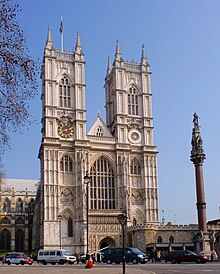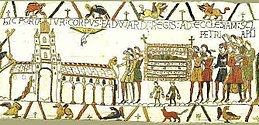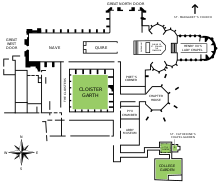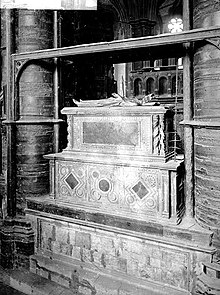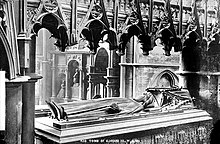Westminster Abbey
Westminster Abbey , German Abbey of Westminster or Westminster Abbey (actually The Collegiate Church of St Peter, Westminster ), is a church in London . It is located in the City of Westminster west of the Palace of Westminster . Traditionally, the kings of England (today: Kings of Great Britain and Northern Ireland ) are crowned and buried here. The Collegiate Church of Collegiate St. Peter, Westminster belongs to the Church of England , but not because of their function diocese belong, but own church ( royal peculiar ) of the British monarchy, similar to exempten monasteries in the Roman Church . Hence their chief clergyman, the Dean of Westminster , is appointed directly by the British monarch.
This church is not to be confused with the Roman Catholic Westminster Cathedral .
history
Benedictine abbey and royal collegiate monastery
The current location was originally the modest abbey church of a Benedictine abbey founded around 960 by King Edgar and Dunstan of Canterbury . Analogous to St Paul's Cathedral , the East Minster , the abbey of the Apostle Peter was given the popular name West Minster (see Münster ).
In the 1040s, Eduard the Confessor moved his residence in the immediate vicinity of the building and had the monastery expanded into a representative abbey in the Romanesque style between 1045 and 1065 . The consecration of the abbey church took place on December 28, 1065. The king was already too sick to attend the festivities and was buried here after his death. The only surviving image of this first abbey can be found on the Bayeux Tapestry .
In 1245, Henry III. commissioned the construction of today's church in the style of French high Gothic . By 1269 the choir, transept and the eastern part of the nave with the adjacent cloister and the chapter house had been completed. A "Henry of Reyns" has been handed down as the architect of this construction phase, who, as the structural forms testify, came from Reims Cathedral . The nave was not erected until one hundred years later in the years 1376–1506, without any change in the system of forms. The lower part of the west facade dates from the 15th century. The two main towers, on the other hand, were only built between 1722 and 1745 by Christopher Wren , Nicholas Hawksmoor and John James , who also adopted the Gothic style. In this regard, Westminster Abbey is the most French of the English Gothic churches. Most of the stone came from Caen in France ( Pierre de Caen ), the Isle of Portland ( Portland ), and the Pays de la Loire region in France. Purbeck marble was used for the stonework and floors of Westminster Abbey, although the various tombstones are made from different types of marble.
The magnificent Lady Chapel of Henry VII , one of the most beautiful late Gothic works in Europe, was built in 1503–1519 in the rich forms of the Perpendicular Style .
In the course of the English Reformation , Henry VIII lifted the Benedictine abbey in 1540 and gave the church the rank of cathedral of the Church of England (until 1550). After the brief return of the Benedictines under Maria I , Elizabeth I established the Anglican collegiate monastery of St. Peter in 1560 , which still exists today.
Coronation Church and Tomb

Since William the Conqueror , all kings of England and the United Kingdom have been crowned in Westminster Abbey. Traditionally, the coronation is performed by the Archbishop of Canterbury . Up to George II († 1760) almost all kings were buried here (see royal graves ).
Construction and equipment
West portal
The main entrance is on the west side. The portal is framed by depictions of the four Christian virtues Truth , Justice , Mercy , Peace and ten martyrs of the 20th century.
Maximilian Kolbe , Manche Masemola , Janani Luwum , Elisabeth von Hessen-Darmstadt , Martin Luther King , Óscar Romero , Dietrich Bonhoeffer , Esther John , Lucian Tapiedi and Wang Zhiming .
Fore and aft
In the central nave is the grave of the Unknown Soldier . In the soil of French battlefields, an unknown soldier from the First World War rests “in the midst of the kings because he served his God and Fatherland well”, as an inscription on black marble proclaims. The fallen of both world wars is also commemorated in the St. George's Chapel.
In the nave are the graves of the African explorer David Livingstone , the poet Ben Jonson and Prime Minister Bonar Law and Chamberlain . In the right (south) transept is Poets' Corner - German: Dichterecke - with a memorial to William Shakespeare and the tombs of Geoffrey Chaucer , Alfred Tennyson, 1st Baron Tennyson , Robert Browning , Henry Wadsworth Longfellow , Charles Dickens , Georg Friedrich Händel u. v. a.
Transepts
Numerous famous British statesmen are buried in the left (north) transept. a. the elder Pitt , Palmerston , Disraeli and Gladstone .
From the northern part of the transept one enters the "Chapel of Edward the Confessor " , located behind the high altar . In the middle is the coffin of the king who died in 1066. Behind it is the coronation chair, in which the Stone of Scone was located until 1996 . The Scottish kings were crowned on this stone for centuries until Edward I took it from the Scots in 1297. The stone was stolen at Christmas 1950 and only found again after a long search. It was officially returned to Scotland in 1996 and has been in Edinburgh Castle ever since . The stone is considered a symbol of the unity of the kingdoms of England and Scotland. In this chapel are the coffins of Henry III. , Eduard I., Eduard III. , Richard II. And Heinrich V.
organ
The organ of Westminster Abbey is on the north and south sides of the western part of the choir nave. The instrument was made in 1937 on the occasion of the coronation of George VI. Built by the British organ builder Harrison & Harrison (Meadowfield). It initially had 84 registers , divided into 4 manuals and pedal . Pipe material from the previous organ, which was built by William Hill in 1848, was reused in the instrument . The two organ cases date from 1895. They were made for the Hill organ.
In the course of a comprehensive overhaul in 1982, the disposition was expanded, in particular that of the Choir Organ , which was equipped with an additional, non-swellable work (Lower Choir Organ).
In 1986 the originally four-manual organ was expanded to include a Bombardewerk (V. Manual, Bombarde Organ) located in the northern triforium . In 2006 the setter system was doubled to 516 storage spaces and numerous pistons (playing aids) were set up. In 2008 the bombing plant was expanded to include the Violone 16 ′.
Today the instrument has the following disposition:
|
|
|
|
|
|||||||||||||||||||||||||||||||||||||||||||||||||||||||||||||||||||||||||||||||||||||||||||||||||||||||||||||||||||||||||||||||||||||||||||||||||||||||||||||||||||||||||||||||||||||||||||||||||||||||||||||||||||||||||||||||||||||||
-
Pairing :
- Normal coupling: III / I, IV / I, V / I, Lower I / II, III / II, IV / II, Upper I / III, IV / III, IV / IV / II, V / IV I / P, II / P, III / P, IV / P, V / P
- Super octave coupling: I / P, III / III, IV / IV
- Sub-octave coupling: III / III, IV / IV
- Playing aids : 512-fold setting system , crescendo roller , various pistons
Gravesites
Royal tombs

The large three-aisled chapel of Henry VII forms the eastern end . The magnificent ceiling is particularly noteworthy. At the end of the chapel, his bones and those of his wife Elizabeth of York rest in a marble coffin . In the left aisle are the coffins of Elizabeth I and Mary I , in the right aisle that of Elizabeth's adversary, the Scottish Queen Maria Stuart .
The following members of the English royal family are buried in the abbey:
- Edward the Confessor, King of England (around 1004 - January 5, 1066)
- Prince Richard (1247–1256) - (son of King Henry III )
- Prince Johann (1250–1256) - (son of King Heinrich III. )
- Prince Heinrich (1256–1257) - (son of King Heinrich III. )
- Princess Katharina (November 25, 1253 - May 3, 1257) - (daughter of King Henry III )
- Princess Joan (1265 - September 7, 1265) - (daughter of King Edward I )
- Prince Johann (June or July 1266 - August 1271) - (son of King Edward I )
- Henry III, King of England (October 1, 1207 - November 16, 1272)
- Aveline de Forz (January 20, 1259 - November 10, 1274) - (Consort of Edmund Crouchback, 1st Earl of Lancaster )
- Prince Heinrich (July 13, 1267 - October 14, 1274) - (son of King Edward I )
- Princess Berengaria (1276–1279) - (daughter of King Edward I )
- Princess Isabella (March 12, 1279 - 1279) - (daughter of King Edward I )
- Prince Alphonso (November 24, 1273 - August 1284) - (son of King Edward I )
- Eleanor of Castile , Queen of England (1241 - November 28, 1290) - (Wife of King Edward I )
- Edmund Crouchback, 1st Earl of Lancaster (January 16, 1245 - June 5, 1296) - (Son of King Henry III )
- Eleanor of England (June 18, 1269 - August 29, 1298) - (Wife of King Alfonso III of Aragon )
- Edward I, King of England (June 17, 1239 - July 7, 1307)
- Edmund, 1st Earl of Kent (August 5, 1301 - March 19, 1330) - (Son of King Edward I )
- John, Earl of Cornwall (August 14, 1316 - September 13, 1336) - (Son of King Edward II )
- Princess Blanche (1342–1342) - (daughter of King Edward III )
- Prince William (June 24, 1348-1348) - (Son of King Edward III )
- Philippa of Hainaut , Queen of England (June 24, 1311 - August 14, 1369) - (Wife of King Edward III )
- Edward III, King of England (November 13, 1312 - June 21, 1377)
- Anne of Bohemia , Queen of England (May 11, 1366 - June 3, 1394) - (Wife of King Richard II )
- Eleanor, Lady Bohun, Duchess of Gloucester (1366 - October 3, 1399) - (Consort of Thomas, Duke of Gloucester)
- Richard II, King of England (January 6, 1367 - February 14, 1400)
- Henry V, King of England (September 16, 1387 - August 31, 1422)
- Philippa de Mohun, Duchess of York (d. July 17, 1431) - (second wife of Edward, Duke of York)
- Catherine of Valois , Queen of England (October 27, 1401 - January 3, 1437) - (Wife of King Henry V )
- Henry VI, King of England (December 6, 1421 - May 21, 1471)
- Princess Margaret (April 10, 1472 - December 11, 1472) - (Daughter of King Edward IV )
- Edward V, King of England (November 4, 1470 - June 22, 1483)
- Richard, 1st Duke of York (August 17, 1473 - April 22, 1483) - (Son of King Edward IV )
- Anne Mowbray , Duchess of York (December 10, 1472 - November 19, 1481) - (Consort of Richard, 1st Duke of York )
- Anne Neville, Lady Beauchamps , Queen of England (June 11, 1453 - March 16, 1485) - (Wife of King Richard III )
- Princess Elizabeth (July 2, 1492 - September 14, 1495) - (daughter of King Henry VII )
- Edmund Tudor, 1st Duke of Somerset (February 21, 1499 - June 19, 1500) - (Son of King Henry VII )
- Prince Edward (around 1502) - (son of King Edward IV )
- Elizabeth of York , King Wife of England (February 11, 1466 - February 11, 1503) - (Wife of King Henry VII )
- Henry VII, King of England (January 28, 1457 - April 21, 1509)
- Prince Henry (January 1, 1511 - February 22, 1511) - (Son of King Henry VIII )
- Prince Henry (1513–1513) - (son of King Henry VIII )
- Edward VI, King of England (October 12, 1537 - July 6, 1553)
- Anne of Cleves , Queen of England (September 22, 1515 - July 17, 1557) - (fourth wife of King Henry VIII )
- Mary I, Queen of England (February 18, 1516 - November 17, 1558)
- Margaret Douglas, Lady Lennox (October 8, 1515 - March 9, 1578) - (Daughter of Margaret Tudor , Queen of Scotland)
- Mary Queen of Scots (December 8, 1542 - February 8, 1587)
- Elizabeth I, Queen of England (September 7, 1533 - March 24, 1603)
- Princess Sophia (June 22, 1606 - June 23, 1606) - (daughter of King James I )
- Princess Mary (April 8, 1605 - September 16, 1607) - (daughter of King James I )
- Anna of Denmark , King Wife of England (October 14, 1574 - April 4, 1619) - (fourth wife of King James I )
- Henry Frederick, Prince of Wales (February 19, 1594 - November 6, 1612) - (Son of King James I )
- James I, King of England (June 19, 1566 - March 27, 1625)
- Charles, Duke of Cornwall (May 13, 1629 - May 13, 1629) - (Son of King Charles I )
- Princess Catherine (June 29, 1639 - June 29, 1639) - (daughter of King Charles I )
- Princess Anne (March 17, 1637 - November 5, 1640) - (daughter of King Charles I )
- Prince Henry (July 8, 1640 - September 13, 1660) - (son of King Charles I )
- Princess Mary Henrietta, Princess Royal (November 4, 1631 - December 24, 1660) - (daughter of King Charles I )
- Charles, Duke of Cambridge (October 22, 1660 - May 5, 1661) - (Son of King James II )
- Elizabeth Stuart , the "Winter Queen" (August 19, 1596 - February 13, 1662) - (daughter of King James I )
- Prince Charles, Duke of Kendal (July 4, 1666 - May 22, 1667) - (Son of King James II )
- Prince James (July 12, 1663 - June 20, 1667) - (Son of King James II )
- Princess Henrietta (January 13, 1669 - November 15, 1669) - (daughter of King James II )
- Anne Hyde, Duchess of York (March 12, 1637 - March 31, 1671) - (first wife of King James II )
- Prince Edgar, Duke of Cambridge (September 14, 1667 - October 7, 1671) - (Son of King James II )
- Princess Catherine (February 9, 1671 - December 5, 1671) - (daughter of King James I )
- Princess Catherine Laura (January 10, 1675 - October 3, 1675) - (daughter of King James I )
- Prince Charles, Duke of Cambridge (November 7, 1677 - December 12, 1677) - (Son of King James I )
- Princess Isabella (August 18, 1676 - March 2, 1681) - (daughter of King James I )
- Princess Charlotte (August 16, 1682 - October 6, 1682) - (daughter of King James I )
- Ruprecht von der Pfalz, Duke of Cumberland (December 27, 1619 - November 29, 1682) - (son of Elizabeth Stuart)
- an unnamed princess (May 22, 1684) - (daughter of Queen Anne )
- Charles II, King of England (May 29, 1630 - February 6, 1685)
- an unnamed child (January 30, 1687) - (from Queen Anne )
- Princess Anne Sophie (May 22, 1686 - February 12, 1687) - (daughter of Queen Anne )
- Princess Mary (June 12, 1685 - February 18, 1687) - (daughter of Queen Anne )
- an unnamed prince (November 1, 1687) - (son of Queen Anne )
- an unnamed child (April 26, 1688) - (from Queen Anne )
- Princess Mary (October 24, 1690 - October 24, 1690) - (daughter of Queen Anne )
- Prince George (April 27, 1692 - April 27, 1692) - (Son of Queen Anne )
- an unnamed princess (April 2, 1693) - (daughter of Queen Anne )
- an unnamed princess (January 31, 1694) - (daughter of Queen Anne )
- Mary II, Queen of England (April 30, 1662 - December 28, 1694)
- an unnamed prince (February 4, 1700) - (son of Queen Anne )
- Prince William, Duke of Gloucester (July 24, 1689 - July 30, 1700) - (Son of Queen Anne )
- William III, King of England (November 14, 1650 - March 19, 1702)
- Prince George of Denmark , Duke of Cumberland (May 1, 1653 - November 8, 1708) - (Consort of Queen Anne )
- Anne, Queen of Great Britain (February 16, 1665 - August 12, 1714)
- Prince George William (November 13, 1717 - February 17, 1718) - (Son of King George II )
- Caroline von Brandenburg-Ansbach , Queen of Great Britain (March 11, 1683 - December 1, 1737) - (Wife of King George II )
- Frederick Louis, Prince of Wales (January 31, 1707 - March 31, 1751) - (Son of King George II )
- Princess Caroline Elizabeth (June 10, 1713 - December 28, 1757) - (daughter of King George II )
- Princess Elizabeth (January 10, 1741 - September 4, 1759) - (Sister of King George III )
- George II, King of Great Britain (November 9, 1683 - October 25, 1760)
- Prince William Augustus, Duke of Cumberland (April 26, 1721 - October 31, 1765) - (Son of King George II )
- Prince Frederick William (May 24, 1750 - December 29, 1765) - (brother of King George III )
- Edward, Duke of York and Albany (March 25, 1739 - September 17, 1767) - (brother of King George III )
- Princess Louisa Anne (March 19, 1749 - May 13, 1768) - (Sister of King George III )
- Augusta von Sachsen-Gotha-Altenburg , Princess of Wales (November 30, 1719 - February 8, 1772) - (Wife of Frederick Louis, Prince of Wales )
- Prince Octavius (February 23, 1779 - May 3, 1783) - (son of King George III )
- Princess Amelia Sophia (June 10, 1711 - October 31, 1786) - (daughter of King George II )
- Henry, Duke of Cumberland and Strathearn (November 7, 1745 - September 18, 1790) - (brother of King George III )
Other graves
The following personalities were also buried in Westminster Abbey:
- Clement Attlee
- Muzio Clementi
- Charles Darwin
- Charles Dickens
- Thomas Sanders Dupuis
- David Garrick
- Orlando Gibbons
- William Ewart Gladstone
- Stephen Hawking
- georg Friedrich Handel
- Lord Kelvin
- John Laird Mair Lawrence
- Pierre François Le Courayer
- David Livingstone
- Isaac Newton
- Laurence Olivier
- Thomas Parry (father)
- Thomas Parry (son)
- William Pitt the Younger
- William Pitt the Elder
- Henry Purcell
- Ernest Rutherford
- Cloudesley Shovell
- Charles Villiers Stanford
- Joseph John Thomson
- Sybil Thorndike
- George Villiers, 1st Duke of Buckingham
- George Wade
- William Wilberforce
- Ralph Vaughan Williams
- Robert Stephenson
- as well as many of the most important English poets and writers, see " Poets' Corner ".
Since 1911, for reasons of space, more and more urns were buried, which was finally made the rule by the chapter. Since 1936 (except in the private crypt of the Dukes of Northumberland ) there has been no coffin burial in Westminster Abbey and its cloister. Similar rules also apply at St Paul's Cathedral .
museum
The Westminster Abbey Museum has been located in the triforium of the abbey church since 2018 and is known under the name "Queen's Diamond Jubilee Galleries". The exhibition is divided into four thematic chapters: building the abbey, devotion and daily life, the abbey and the monarchy and the abbey and national memory.
Exhibitions
In addition to a collection of royal burial objects (e.g. the funeral saddle, helmet and shield of Henry V), a series of medieval glasses, sculptural fragments from the 12th century, the collections of the museum also contain the coronation chair of Queen Mary II. Replicas of the crown jewels and historical portraits of Edward III, Henry VII and his wife, Elizabeth I, Charles II, William III, Mary II and Queen Anne.
Wax figures of Horatio Nelson and Prime Minister William Pitt show them in some of their original clothing. As part of restoration work on a portrait of Elizabeth I, an original corset was found, which is dated to 1603.
Another exhibit is England's oldest surviving altarpiece, the Westminster Retable from the late 13th century. Most likely, it was designed for the high altar of the Abbey and was badly damaged in the past centuries - it was carefully cleaned and preserved for exhibition.
literature
in alphabetical order by authors / editors
- Anthony E. Harvey: The funeral effigies of Westminster Abbey. Woodbridge et al. a. 2003, ISBN 0-85115-879-X .
- Richard Jenkyns: Westminster Abbey. Cambridge, Mass. 2005, ISBN 0-674-01716-1 .
- NN: A bibliography of Westminster Abbey. A guide to the literature of Westminster Abbey, Westminster School and St. Margaret's Church published between 1571 and 2000 compiled by Tony Trowles. Woodbridge et al. a. 2005, ISBN 1-84383-154-6 .
- Tim Tatton-Brown (Ed.): Westminster Abbey. The Lady Chapel of Henry VII. Rochester, NY 2003, ISBN 1-84383-037-X .
- Eva-Andrea Wendebourg: Westminster Abbey as a royal burial place between 1250 and 1400 = manuscripts for art history in the Wernersche Verlagsgesellschaft 11. Wernersche Verlagsgesellschaft , Worms 1986. ISBN 978-3-88462-910-9
Web links
- Westminster Abbey website (English)
- Westminster Abbey as a 3D model in SketchUp's 3D warehouse
Individual evidence
- ↑ a b c History of Westminster Abbey
- ^ Johann Josef Böker : English sacred architecture of the Middle Ages . Wissenschaftliche Buchgesellschaft, Darmstadt, 1984, ISBN 3-534-09542-1 , pp. 190-200 and 284f.
- ↑ On the organ of Westminster Abbey ( Memento from July 31, 2013 in the Internet Archive )
- ^ The Queen's Diamond Jubilee Galleries. Retrieved January 12, 2020 .
Coordinates: 51 ° 29 ′ 58 ″ N , 0 ° 7 ′ 39 ″ W.
